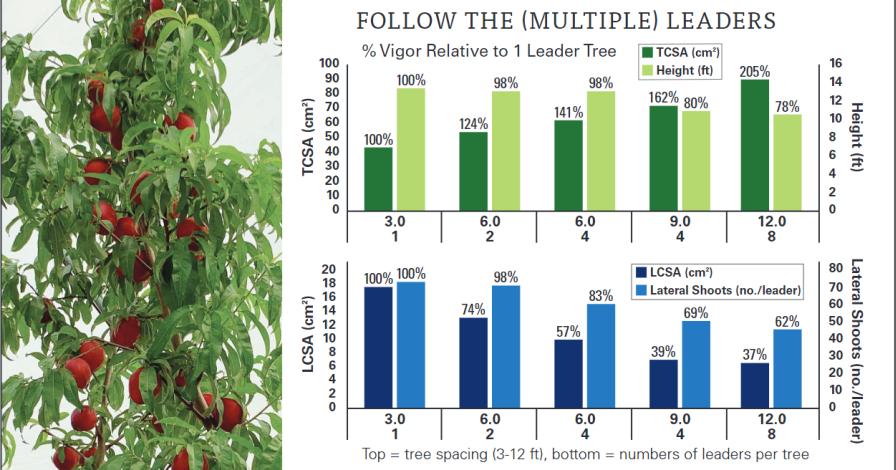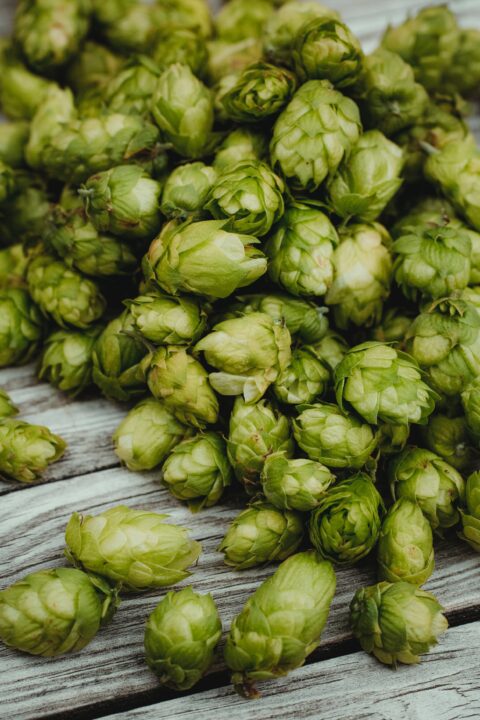Precision-Ready Peach Orchards Growing Into a Thing of Beauty
The introduction of greater precision to peach orchard management has been facilitated by dwarfing rootstocks and training techniques that achieve trees that are smaller in stature with simplified, more uniform fruit-bearing architectures for easier quantification (and therefore manipulation) of leaf area and crop load.
Furthermore, these canopy architectures have become more “two-dimensional” or “planar” to create narrow fruiting wall orchards that optimize light interception with minimal shading, promoting more uniform and higher-quality fruit development. Planar orchards also more readily facilitate potential adoption of mechanization (canopy hedging, string-thinning of blossoms), more efficient and uniform spray applications, and new sensing/imaging technologies that are the foundation of automating precision data collection and developing future robotic applications.
The NC140 ‘Cresthaven’ peach rootstock trials, planted in 2017 across the U.S., planned and coordinated by Dr. Greg Reighard at Clemson University and Dr. Ioannis Minas at Colorado State University, are now five years old. These are beginning to provide exciting data for peach growers whose access to truly vigor-limiting rootstocks has long lagged behind that for apple and sweet cherry producers. In Michigan State University’s trial, planted on sandy soil near Benton Harbor, comparative vigor (using Lovell seedling rootstock as the industry standard) ranges from highly vigorous (Guardian at 128% of Lovell) to semi-vigorous (Controller 6 and Rootpac 20 at 78% and 64%, respectively) to semi-dwarfing (Controller 8 and Controller 7 at 54% and 39%, respectively) to dwarfing (MP-29 and Rootpac 40 at 27% and 26%, respectively)!
USING THE TOOLS
With such a wide range of vigor control becoming available to growers, research efforts are increasing to develop appropriate training techniques for canopy architectures that can best utilize these rootstock “tools.” We began peach/nectarine (and plum and apricot) canopy architectural research in 2011, with standard vigor rootstocks, to compare some of the architectures we had been studying for sweet cherry, including Tall Spindle Axe (TSA), Super Slender Axe (SSA), and Upright Fruiting Offshoots (UFO).
In that initial trial, SSA and UFO showed the most promise, as both utilize horticultural tools to impose vigor management: SSA with its extreme annual short-pruning of lateral fruit-bearing shoots and root competition from very close plant spacing, and UFO with its diffusion of vigor into multiple vertically oriented mini-leaders. UFO training for peach was altered slightly from what we use for sweet cherry, plum, and apricot since those species bear fruit on spurs and/or very short shoots, while peach/nectarine bears on previous-season lateral shoots, meaning the upright fruiting offshoots must be spaced wider to accommodate new lateral shoot growth annually.
Consequently, we planted our next generation peach/nectarine canopy architecture trial in 2017 adjacent to the NC140 rootstock trial, utilizing SSA-style short pruning of lateral shoots and a range of multiple UFO-style vertical leaders: 1, 2, 4, 6, or 8 per tree. At the five-year mark of this trial, one of the most interesting results is the strong impact of leader number (and wider tree spacing) on tree vigor as compared by trunk cross-sectional area (TCSA) (see top graph on previous page). Relative to a single-leader tree, two leaders (and proportionally increased tree spacing) increase vigor by 24%, four leaders by 41%, six leaders by 62%, and eight leaders by 105%. This is comparable to the range of different vigors imparted by rootstocks in the NC140 trial.

This ‘Fantasia’ peach trial, which included one to eight leaders per tree, with one fruit per lateral shoot, shows vigor comparisons determined by trunk and leader cross-sectional areas (TCSA, LCSA), tree height, and lateral shoot number per leader.
Graphic courtesy of Michigan State University
WATCH THAT VIGOR
Also of importance to orchard management is the vigor of the component fruiting structures (the SSA-pruned UFO leaders), as excessive vigor could be manifested in more and longer lateral shoots, creating shade and requiring more pruning, while inadequate vigor could be manifested in an insufficient number of fruit-bearing shoots or leaf area to support quality fruit development. Leader number inversely and strongly impacts these component parameters (leader height, top graph; LCSA and lateral shoot number, see bottom graph).
Thus, peach/nectarine growers now have two very powerful tools — rootstocks and simplified canopies comprised of variable numbers of vertical leaders — for designing new orchards for more manageable vigor control and for harnessing the advantages of precision canopy management strategies and rapidly advancing orchard technologies.
Ongoing research will refine key management parameters to optimize the components of crop load balance — leader number matched to rootstock vigor, target fruiting shoot number per leader, shoot leaf area per fruit, timing of SSA pruning, and summer hedging, etc.










